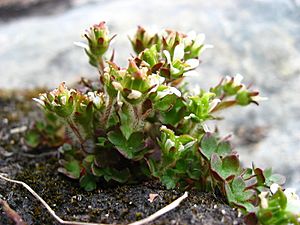Pygmy saxifrage facts for kids
Quick facts for kids Pygmy saxifrage |
|
|---|---|
 |
|
| Saxifraga hyperborea | |
| Scientific classification | |
| Genus: |
Saxifraga
|
| Species: |
hyperborea
|
| Synonyms | |
|
|
The pygmy saxifrage, also known by its scientific name Saxifraga hyperborea, is a small but tough plant. It is found in cold, northern parts of the world. This plant is special because it can grow in very harsh environments.
It is native to places like Canada, Alaska, Greenland, Russia, and Spitsbergen. You can also find it in the high mountains of the western United States. There was once a report of it growing on Mount Washington in New Hampshire, but this has not been fully confirmed.
What is Pygmy Saxifrage?
The pygmy saxifrage is a tiny plant that often grows in a mat-like shape. It can sometimes look purple, which makes it stand out. This plant has a strong, woody base that helps it survive in tough conditions.
Appearance
This plant is quite small. Its flowers are usually purple or white. Each flower is only about 5 millimeters wide. Even though they are tiny, these flowers add a touch of color to the cold landscapes where the plant lives.
Where It Grows
Pygmy saxifrage loves wet places. It grows well in wet tundra, which is a type of treeless plain found in cold regions. You can also spot it near melting snow banks, along stream banks, and by the sides of lakes. It can grow at very high elevations, sometimes up to 3,000 meters (about 9,800 feet) above sea level.
In the United States, some groups of this plant have been called by different names in the past. These names include S. debilis or S. rivularis. This shows how scientists sometimes give different names to plants that are very similar.
See also
 In Spanish: Saxifraga hyperborea para niños
In Spanish: Saxifraga hyperborea para niños

